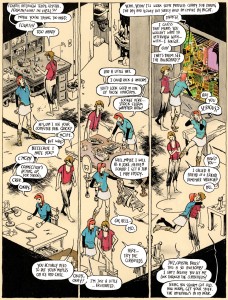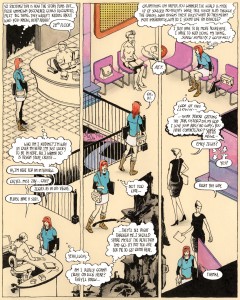With Zegas #2 out from the printer and into the world, I wanted to take a closer look at the super panel breakdown, which I use all throughout the issue.
You’ll recognize the trick, it’s simply one larger image broken down into pieces OR one larger image with characters moving within it . I wanted to take advantage of a double page spread to choreograph Emily Zegas’ body language through her several moods and locales. The tricky part was making sure the eye was led exactly where it should go. Turns out the heavy lifting is done by the words, the conversations, the thought balloons. The flow goes down the panel , then up the next, then back down, etc.
You can call these my “Marcos Martin” pages. I won’t deny it, he’s been an influence for a while and I’m sure sequences like this were around at the time I was originally cooking my pages up:
Marcos has made a career of leaving his peers in the dust. He doesn’t toy with a layout, he commands it, and no one in contemporary adventure comics comes close to achieving what he achieves on a regular basis. The scene up there is just one big room in one panel, also used in a double page spread. We follow Spider-Man, our eyes being led to the right then back to the left, punctuated by inset panels.
THERE’S A TIME AND A PLACE
Another main influence on this approach is Chris Ware, another storytelling master who occasionally uses the panels to reflect different seasons, eras, or time signatures. This Big Tex page does it all.
It’s no secret that Ware had been influenced by Richard McGuire and his seminal story “Here”, from 1989…
… but the real godfather of the page-as-map is Frank King and his Gasoline Alley strip.
[Matt Seneca wrote a great piece on King over at his recently defunct column Your Wednesday Sequence. Seneca also tackled the same Marcos Martin scene I was talking about.]
GUTTERS
Going over the overblown staging in these pages reminds me of the smaller examples, the panels that are broken into fragments in order to delay time, build tension, or reveal story details. In We3, Frank Quitely took a Grant Morrison story and took it into visually innovative territory. This modest sequence, however, is nicely paced.
Was it a callback to Harvey Kurtzman, that scene? I’d like to think so. Kurtzman was a true virtuoso of all of these narrative tics and bumps, his war comics being prime vehicles for strong and smart material. These three panels are works of beauty, captions be damned.
This batch, courtesy of Jim Steranko, works well enough but isn’t quite necessary. The image’s story does progress, and the gutter breaks do make the eye start and stop. Steranko was more than capable of managing subtlety, and this scene certainly tries to build up a sense of weight, but it still feels like a faint attempt.
Same here (Steranko again). As if mid-air speech wasn’t hard enough to swallow, the gutter breaks seem to be used as mere window dressing. Maybe it was to show that more… panels had been drawn? Steranko, after all, was once nearly denied payment for writing a silent page. Either way, the balance of dialogue and movement can make or break a moment; this one’s a dud.
Just one more dud. Actually, the panel break would’ve been useful if the image actually revealed something, maybe the very thing that’s being explained. I gotta admit, this is a pretty funny out of context scene, but that may have something to do with those tears. Deluxe Format tears.
Here’s a pretty simple but effective Frank Miller shot…
… and here’s another one that justifies the breakdown treatment in a different way. The gutters stagger the eyes one panel at a time while the monologue unravels at its own pace. It’s confident work, and in Miller’s pre-Sin City comics, this type of rhythm is dominant.
Oh, and punchlines. They’re good reasons to break up a panel. Julie Doucet knows the score.
BRING IT HOME
Back to the page as a setting, Gianni De Luca did some incredible, jaw dropping sequences in his time. As far as I can tell, his work was serialized in Il Giornalino. This il Commissario SPADA page is from 1979…
… but his most revered work continues to be his adaptation of Hamlet. Here’s a two page spread from Amleto, from 1976 (the entire story is made up of double page spreads, with a usual change in location per page turn). Click on it and bask in its glory.
I can’t help but think of this John Romita Jr. two pager, perhaps his most imaginative and ambitious sequence yet… and it’s only a walking figure. Such simplicity!
So there you go, a few drops of inspiration on how to stretch and maximize the real estate within an image, a panel, or a page or two. I’m not sure whether the reader should be made aware of such mechanisms, but some of these pages are too bombastic to ignore or be taken passively.
I should shut my yap. Let the work speak for itself and all that, right? Case in point, click away:
Buy Zegas #2 online or directly from me this upcoming weekend, in case you find yourself in Portland’s own comic-fest Stumptown!
–Fiffe
UPDATE: Criminally Left Out
Thanks to Marc Sobel for reminding me of this great scene by Jaime Hernandez.
I don’t recall Jaime using this method very often but when he does, it is spot on (from Love & Rockets #29, “Flies on the Ceiling“, 1989). Calling him a master storyteller isn’t enough, so let’s just agree that the guy’s a genius. Thanks for the reminder, Marc!





















15 replies on “Panel Über Alles”
Good stuff, Michel. Marshall Rogers was also a master of the super panel. Have you ever seen Demon with a Glass Hand? Or Detectives Inc.? And of course Xaime has used it from time to time. Remember that scene where Izzy confronts the devil at the dance in Flies on the Ceiling? I’m sure there are tons of others examples out there.
@Marc: Good catch, sir! Fixed it post-haste! A gross oversight on my part.
As for Rogers, his Detective Inc. stuff is great, but it’s his run on Detective Comics that really does it for me. His work in general deserves more study. Never seen the Glass Hand trade, but now I must seek it out.
Multi-panels ruled in the 70s http://theperiodicfable.wordpress.com/comics-index-of-multi-panel-pans-by-decade/1970s-multi-panel-pans/ and a more recent Iron Fist http://www.amiwiitos.com/comics/iron-fist/ironfist.gif
Nice work.
Another ultra-panel here: (S. Clay Wilson – NSFW)
http://zizki.com/comics/96065-1/zapcomix03-4-a24.jpg
BTW: That Wilson page is from Zap Comix # 3, 1968.
I think Quitely’s best use of the “super panel” was, appropriately enough, in All-Star Superman: http://bit.ly/Iodium
…and, of course, it all comes back to Marcel Duchamp: http://to.pbs.org/JGhLfF
Scott McCloud would insist that this technique is called a polyptych, but “super panel” is much more comics!
Re: my earlier comment, I think I was getting my 80s DC graphic novels confused. The one I was actually thinking of was not Marshall Rogers, but Keith Giffen in Hell on Earth. Check this out!
http://tinyurl.com/7uxxgtk
Do I remember Eisner doing this way back when? I don’t have all his collected works on hand, so I’m not sure if my memory is failing me. I’ll look around and get back to you on that!…
Also, who drew the Green Arrow panels?
Just a small note on the Steranko panels: Stan wrote them, and he never really understood what Jim was after. As Chandler and Outland show, Steranko was obsessive about text placement, and the two Cap panels are pretty sloppy there, especially the second one. There is a reason Steranko did not do more Captain Americas, because he really loved the character at the time. Stan was always more conservative in the writing and storytelling aspects — not wrong, just more comfortable with the six-panel Kirby page approach. When Steranko fractured the page layouts, Stan tried to “explain” them through the script, with these results. Both men are unique giants, but their strengths did not complement each other on the Caps.
[…] 1) Michael Fiffe on “superpanels” — http://michelfiffe.com/?p=1947 […]
[…] So… I’ve written about these comics-panels-with-multiple-images-across-one-background before, and have been collecting examples from the 1900s through recent years. They’re called polyptychs or multi-panel pan sequences or multi-pans… but I just learned a new term for them: Super Panels. Ay… it’s so refreshingly low-brow! There’s a good collection of them, with discussion, etc., at Michel Fiffe’s website. […]
@Seth – Wow, that first link has tons of good examples.
@Briany – Kinda difficult not to love that page!
@Gavin – Quietly can do no wrong in my eyes.
@Marc – “Hell on Earth” was Giffen’s best work yet. The entire thing is just as imaginative.
@Timbone – Ed Hannigan.
@Ken – I can see the working conflict, definitely, especially when Lee’s quiet moments were at odds with the way Steranko would portray a quiet moment. That tension never seemed to click.
[…] hands of master, including Frank Miller. Generally, though, I think that a super panel should (per Michel Fiffe’s description) “to delay time, build tension, or reveal story […]
As an Reader and As an Artist I have always been fascinated with this Technique . the One the one that caught my eye early on was in Issue Two of Erik Larsen`s Savage Dragon Mini series where Dragon fights Mako ,Hellrazer and Basher in a Mall . the speed and Movements of Dragon leaping across the three panels doing a Summer-salt to punch Hellrazer in the face was Brilliant . I had even practice a little Juxtaposition onj an Page of my Web Comic Here : http://thevalkyirequartet.com/2012/08/29/the-calm-before-the-storm-11/ . [ this was my first attempt I did last year ] and I tried it again on two other comics . but after reading this it has inspired me to try a take a few more different Approach and apply them to quiet scenes and Establishing shots to give my work a more cinematic feel . personally I do look at Marcos Martin`s on Amazing Spider-Man and the Private Eye for proper examples of how to do Juxtaposition right in my own projects . I feel like I should do it more often ^_^ Via La Superpanels
personally I do look at Marcos Martin`s on Amazing Spider-Man and the Private Eye for proper examples of how to do Juxtaposition right in my own projects . I feel like I should do it more often ^_^ Via La Superpanels
[…] de nommer « polyptyques » ce type de séquence (pour en savoir plus, voir ici et là). Autre exemple « bâtard » de nature plus expérimentale : Travelling […]